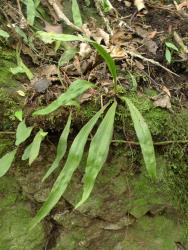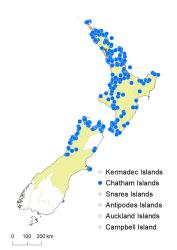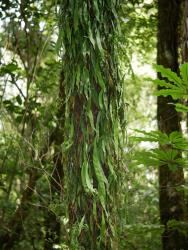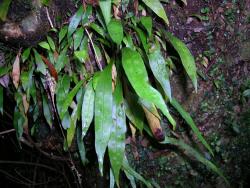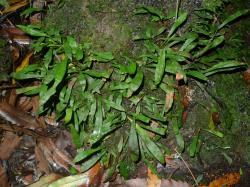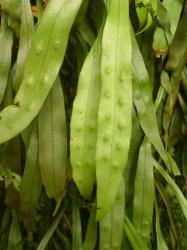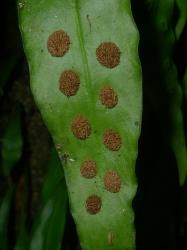- ≡ Polypodium dictyopteris Mett., Ann. Sci. Nat. Bot. sér. 4, 15: 77 (1861)
- ≡ Anarthropteris dictyopteris (Mett.) Copel., Gen. Fil. 218 (1947)
- = Dictyopteris lanceolata J.Sm., J. Bot. (Hooker) 4: 64 (1841) nom. nud.
- ≡ Anarthropteris lanceolata (J.Sm.) L.B.Moore in Allan, Fl. New Zealand 1, 1010 (1961) nom. illeg.
- = Dictymia lanceolata Hook.f., Bot. Antarct. Voy. II (Fl. Nov.-Zel.) Part II, 43 (1854)
- ≡ Polypodium cunninghamii Hook., Gard. Ferns t. 30 (1862) nom. nov. pro Dictymia lanceolata Hook.f. 1854
- ≡ Anarthropteris lanceolata (J.Sm. ex Hook.f.) Pic.Serm., Webbia 29: 13 (1975)
Low epiphytic or rupestral ferns. Rhizomes erect, scaly, bearing proliferous roots. Rhizome scales clathrate, narrowly ovate, 2–7 mm long, 0.5–1 mm wide, squarrose, brown, entire. Stipes indistinct from lamina, not obviously articulated to rhizome. Fronds undivided, narrowly elliptic to narrowly obovate, 40–360 mm long, 4–35 mm wide; apex acuminate or sometimes acute; margins entire or rarely slightly toothed; base attenuate to an indistinct winged stipe; adaxial surface dark green; abaxial surface slightly paler; herbaceous to coriaceous; glabrous except for widely scattered scales at the base. Costa prominent on adaxial surface; veins reticulate; areoles without free included veinlets; hydathodes absent. Sori round or slightly elongate, 3–7 mm long, partly impressed into lamina forming low bulges on adaxial surface, in 1 row either side of the costa, closer to costa than margin, usually confined to distal half of frond; paraphyses present as very narrow clathrate scales c. 3 cells wide; exindusiate.
This species is easily recognised by its undivided fronds, and large, exindusiate, round or slightly elongate sori. The proliferous roots, giving rise to new plants at intervals, can be confused for a creeping rhizome, but the species has an erect rhizome, which distinguishes it from Pyrrosia species and juvenile plants of Lecanopteris species. It can be further distinguished from Pyrrosia by its glabrous lamina, and from Lecanopteris by its lack of free, included veinlets in the areoles.
Occasional aberrant fronds are found, either crested at the apices or with the lamina divided into short, lateral segments.
North Island: Northland, Auckland, Volcanic Plateau, Gisborne, Taranaki, Southern North Island.
South Island: Western Nelson, Sounds-Nelson, Westland, Canterbury.
Chatham Islands.
Altitudinal range: 0–1000 m.
Loxogramme dictyopteris is common throughout coastal and lowland regions of the North Island, extending locally into montane areas. It occurs from near sea level, up to 675 m in Erua Forest, and 1000 m on Mt Pihanga near Lake Taupō, but is uncommon in the higher areas of the Volcanic Plateau and Gisborne. In the South Island it is mostly confined to coastal and lowland areas of the Marlborough Sounds and Nelson, growing up to 450 m near Punakaiki, and extending as far south as Lake Kaniere on the west coast, and Banks Peninsula on the east coast. It also reaches the Chatham Islands.
A low epiphyte on trunks and fallen logs, or on acidic and calcareous rocks and banks, in damp shaded parts of coastal and lowland broadleaved forest; sometimes in shaded hollows of open scoria. It covers large areas on trunks or rocks owing to its proliferous roots, but rarely occurs far above ground level. It often wilts conspicuously in dry weather.
n = 37 (Brownlie 1958, as Anarthropteris dictyopteris).
This species has a complex taxonomic history, documented by Pichi Sermolli (1975). The earliest name, Polypodium attenuatum R.Br., used by Richard (1832), was a misidentification for what is now known as Dictymia brownii (Wikstr.) Copel., but was in any case illegitimate because of a previously published homonym. The species was first validly described as Dictymia lanceolata by Hooker (1855), but when transferred to Loxogramme, Copeland (1929) had to base his new combination on a later name, Polypodium dictyopteris Mettenius (1861), because the combination based on D. lanceolata was pre-occupied in Loxogramme. However, when he transferred it again to his new genus Anarthropteris, Copeland (1947) incorrectly used the combination Anarthropteris dictyopteris, overlooking the earlier binomial, Dictymia lanceolata. Moore (in Allan 1961) established the correct combination, Anarthropteris lanceolata, but attributed the species name incorrectly to J. Smith, rather than J.D. Hooker. This error was corrected by Pichi Sermolli (1975), who established the correct name, Anarthropteris lanceolata (J.Sm. ex Hook.f.) Pic.Serm. However, when treated in Loxogramme, the correct name is L. dictyopteris (Mett.) Copel. (Kreier & Schneider 2006).



